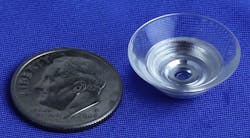1-mm-thick telescopic contact lens magnifies by 2.8X
San Diego, CA--Researchers at the University of California, San Diego (UCSD) have devised a telescopic contact lens that can switch between normal and magnified vision by using slightly modified off-the-shelf 3D-television glasses. The contact lens has positive and negative annular concentric reflectors that form a telescope, and also contains a liquid-crystal shutter; the rest of the lens is made of polymethyl methacrylate (PMMA) and includes diffractive chromatic aberration correction.
The researchers, led by Joseph Ford, a UCSD professor of electrical engineering, built a prototype of the lens and tested it on a mechanical eye.1 The researchers report their findings in the June 27 online issue of Optics Express, an open-access journal of the Optical Society.
One use: helping AMD sufferers
The lens could ultimately be used to improve vision for patients suffering from age-related macular degeneration (AMD), a condition that causes loss of vision in the center of the visual field. AMD patients typically cannot read or recognize faces. Last summer, UCSD researchers worked with partners at Innovega and Paragon Vision Sciences to conduct human clinical trials on a preliminary version of the wearable lens. A second round of clinical trials will occur later this year.
The contact lens developed by Ford’s team is 1 mm thick; its mirrors are made of aluminum and magnify the image 2.8 times. Unlike today's implanted telescopic lenses, the contact sits noninvasively on the eye's surface. The optics make it possible to switch between normal and magnified vision by combining the contact lenses with "active shutter" glasses worn to watch some 3D televisions.Without the 3D glasses, the contact lenses superimpose both normal and magnified images. With the glasses on, a liquid-crystal shutter will select between normal or telescopic vision. The researchers are working on a hands-free switch that uses a low-power infrared LED to monitor when the user blinks with both eyes or winks with one eye to activate one of the two functions.
The researchers tested the lens on a life-size mechanical eye that they built. The model was connected to an imaging system; the researchers compared actual performance with computer simulations. Tests performed with the mechanical eye showed that the lens’ magnified image provides a much larger field of vision than other magnification approaches currently in use. The quality of the images was also good.
PMMA now, permeable polymer later
The PMMA contact material is not permeable to gases, meaning the contact lens can only be worn for a short period of time. The researchers are now working on a design that uses a material permeable to gases. They also are working to correct chromatic aberrations without the use of diffractive optics.
The finished contact lenses will have polarizers integrated into the center or edge of the contact lens surface. In early lab tests the polarizers were attached externally, and a pair of 3D TV glasses was modified to do the switching.
“In the future, it will hopefully be possible to go after the core of the problem with effective treatments or retinal prosthetics,” said Eric Tremblay, coauthor on the paper and alumnus of Ford’s research group, now at the École Polytechnique Fédérale de Lausanne (EPFL) in Switzerland. “The ideal is really for magnifiers to become unnecessary. Until we get there, however, contact lenses may provide a way to make AMD a little less debilitating.”
Source: http://www.jacobsschool.ucsd.edu/news/news_releases/release.sfe?id=1386
REFERENCE:
1. Eric. J Tremblay et al., Optics Express, Vol. 21, Issue 13, p. 15980 (2013); http://dx.doi.org/10.1364/OE.21.015980

John Wallace | Senior Technical Editor (1998-2022)
John Wallace was with Laser Focus World for nearly 25 years, retiring in late June 2022. He obtained a bachelor's degree in mechanical engineering and physics at Rutgers University and a master's in optical engineering at the University of Rochester. Before becoming an editor, John worked as an engineer at RCA, Exxon, Eastman Kodak, and GCA Corporation.

